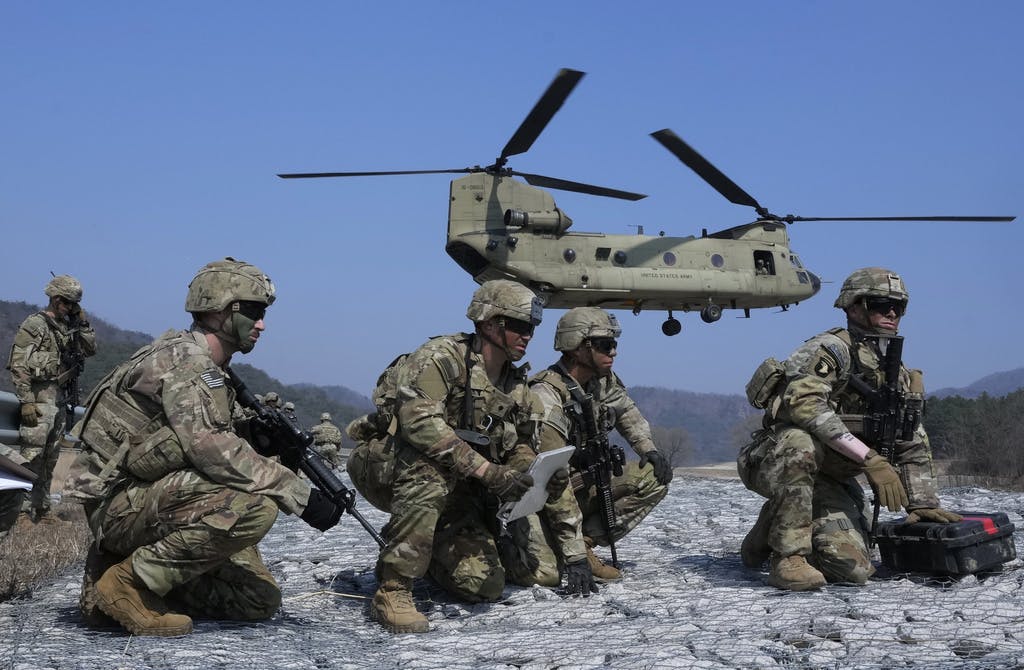U.S. Marines Storm Beaches Southeast of Seoul Alongside South Koreans in ‘Double Dragon’ War Games
The assault is the latest in two weeks of ‘Freedom Shield’ exercises in which the Americans and South Koreans are challenging North Korea’s threats and missile tests in displays of military might on land, in the air, and at sea.

American and South Korean Marines carrying heavy weapons and packs roared ashore 170 miles southeast of Seoul in a display showing they are pumped and primed for a second Korean War.
The joint exercise Wednesday marks the reversal of the policies of the previous South Korean president, who banned the allies from joining in realistic war games while looking for rapprochement and dialogue with North Korea.
The excitement of the Americans and South Koreans over joining forces in the first such landing in five years permeated the atmosphere on both sides. A Marine officer, Lieutenant Colonel Eric Olson, said the exercise showed the Americans were “ready to fight” with their South Korean ally.
“This exercise is designed for the combined defense of the peninsula,” he said in a statement that he had carefully memorized, as American Marines advanced from their landing craft into the tree line beyond the beach. “It’s important for regional stability.”
The war games are called Ssangyong for “Double Dragon,” that is, American and South Korean forces. They’re the latest in two weeks of “Freedom Shield” exercises in which the Americans and South Koreans have challenged North Korean leader Kim Jong-un’s rising threats and missile tests in displays of military might on land, in the air, and at sea.
Colonel Olson, executive officer of the 13th Marine expeditionary unit that landed on the broad sandy beach on the edge of the industrial port of Pohang, said the important aspect of the exercise was “the interaction that we have with the Marines and sailors from the Republic of Korea” — South Korea.
The point, echoed Captain Kevin Buss, also with the 13th Marine expeditionary unit, was “to build allied capacity and enhance Indo-Pacific regional security through combined, integrated naval power.”
That degree of interaction was lost when South Korean liberal ex-president, Moon Jae-in, stopped live war games involving American and South Korean troops while looking for reconciliation with North Korea.
Also, President Trump, after meeting Kim Jong-un in Singapore in June 2018, played into Mr. Kim’s hands by abruptly canceling exercises that had already been planned without telling his defense secretary, General James Mattis.
American and South Korean commanders are counting on South Korea’s conservative president, Yoon Seok-yeol, who defeated a liberal candidate in last year’s election, to keep up the same intensity of cooperation through his five-year term.
They have often said exercises mimicking war-time realities, not just the tabletop games that Mr. Moon reluctantly condoned, are needed to be sure of defense against the North
South Korean commanders were just as pumped as the Americans. The commander of the South Korean Marines who landed on the beach in the first wave before the Americans, Colonel You Chang-hoon, vowed “our Marine forces will immediately punish enemies in the event of any provocation.”
Such training, he said, would “establish a posture for decisive battles” and build up the “sturdy alliance” between the Americans and Koreans.
As if to dramatize his words, a pair of South Korean F35 fighters zoomed high above the training area followed by the Marines’ tilt-engine Osprey helicopters, capable of landing and taking off vertically and tilting their engines forward to fly like propeller-driven aircraft. Marine Apache attack helicopters also joined the assault.
All told, more than 2,000 American Marines and about 3,000 South Korean Marines and sailors are participating in the exercises, due to conclude next Monday. The Marines, American and Korean, were supported by about 30 naval vessels. Lurking on the horizon was the USS Makin Island, a combination assault ship and transport, from which the Osprey helicopters fly.
The U.S. Korea Forces command opened the training area to Korean and foreign media to show off the revival of full-scale war games and the rapport between their armed forces. The Marines were under orders to remain silent beyond prepared statements.
Both the commander of America’s 28,500 troops in South Korea, General Paul LaCamera, and the chairman of South Korea’s joint chiefs, General Kim Seung-kyum, witnessed the exercise but were not available for comment.
General LaCamera is also commander of the Combined Forces Command, including American and South Korean troops, and the United Nations Command, which includes troops of all 16 nations in the Korean War.
The Marines’ avoidance of the press reflected the sensitivity of the exercises among Koreans. Mr. Yoon was elected last year by a tiny margin, and his foes, many of whom oppose his hard-line policy, still hold a majority in the national assembly.
In the ebb and flow of Korean politics, it’s always possible that a liberal government will rise again in South Korea. South Korean leftists continue to demand moves toward reconciliation.
Kim Jong-un warns of American and South Korean “war preparation moves” and calls for building up the North’s nuclear stockpile while refusing to consider giving up his nuclear program.

